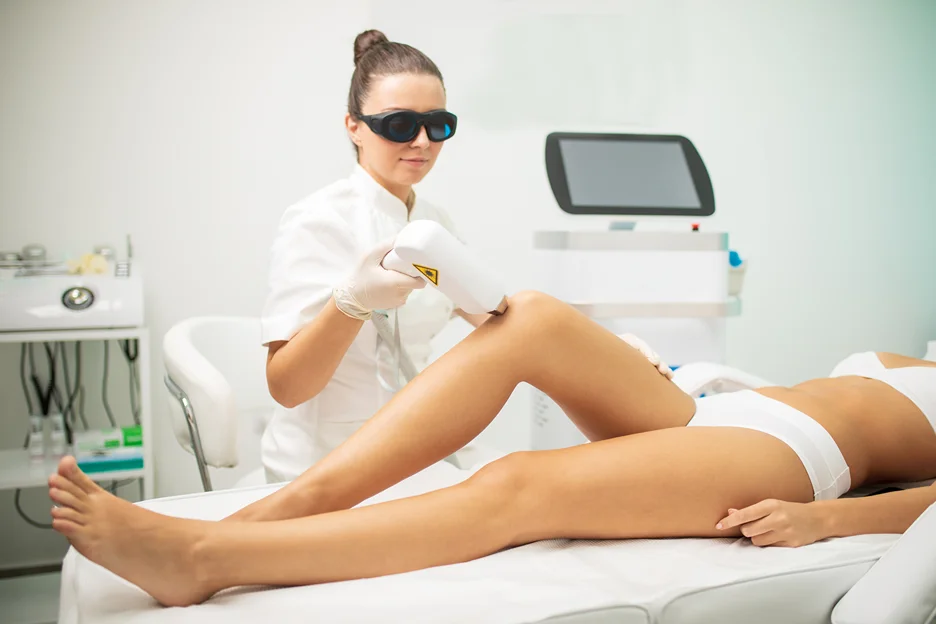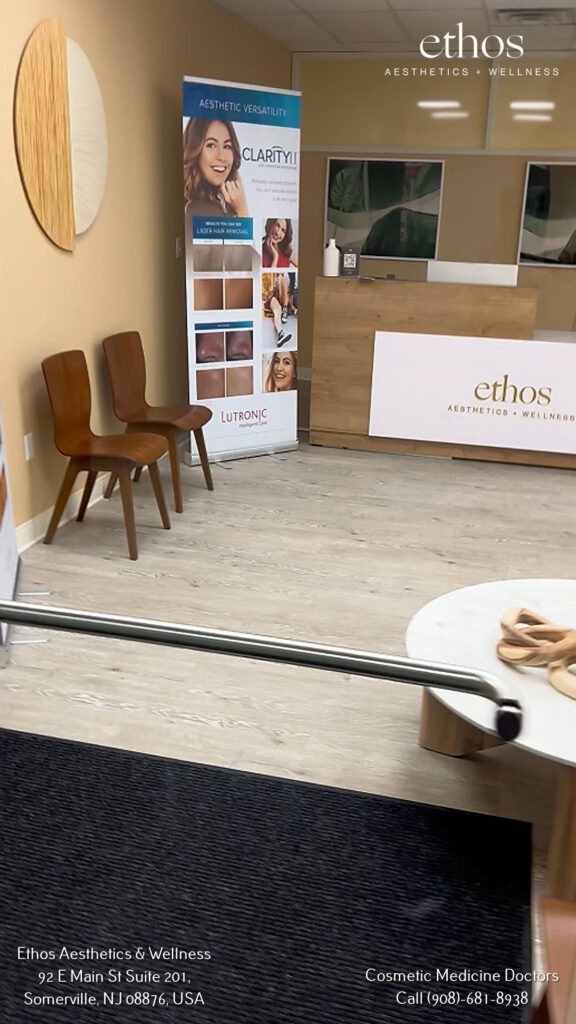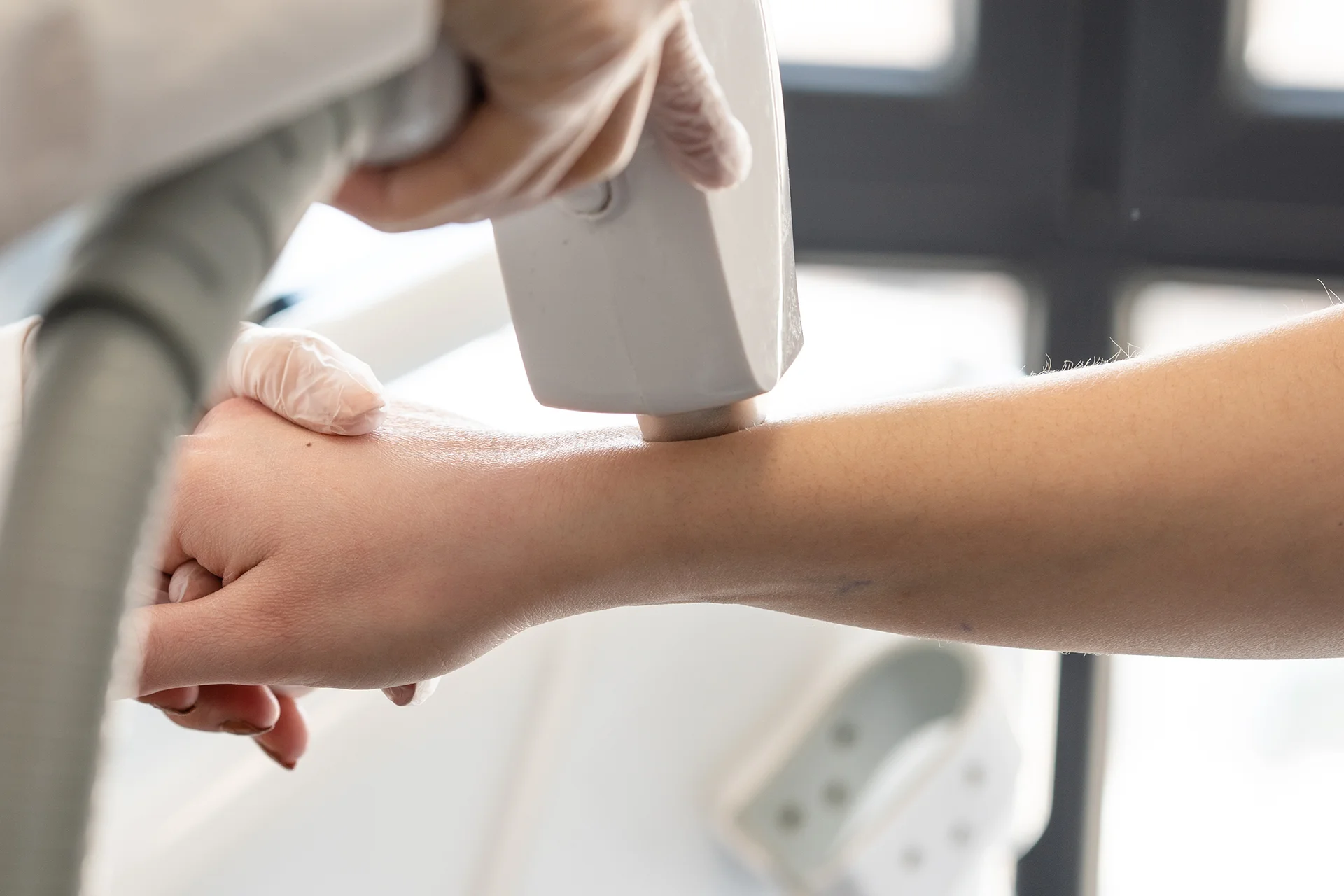How Effective Is Laser Against Keratosis?
Keratosis pilaris (KP) is a common, harmless skin condition characterized by small, rough bumps primarily on the upper arms, thighs, and buttocks.
At Ethos Aesthetics + Wellness, we receive many inquiries if laser hair removal can help treat KP. Below, we’ll examine the causes of keratosis pilaris, why lasers may improve its appearance, and what patients can expect from treatment.
What Causes Keratosis Pilaris?

Keratosis pilaris results from a buildup of keratin, a protein found in skin, hair, and nails. Keratin normally rises to the surface and sheds, but in KP it accumulates around hair follicles. This causes harmless but unsightly bumps.
While a cure isn’t available, KP often improves with age. It tends to be at its worst during adolescence. KP triggers include:
- Dry skin – Low moisture levels cause excess keratin and clogged follicles.
- Rubbing or friction – Skin irritation from tight clothing can worsen KP.
- Cold, dry weather – Lower humidity dries the skin.
- Genetics – KP has a hereditary component, often running in families.
KP has no serious health complications. However, many patients seek treatment for cosmetic reasons or discomfort. Rough bumps may cause itching, irritation, and redness, especially when rubbing against clothes or during heat, sweating, or cold weather.
How Can Laser Hair Removal Improve Keratosis Pilaris?
While lasers don’t directly treat the root keratin accumulation cause, they can indirectly improve KP’s appearance in a few ways:
1. Removing Hair Follicles
LASER energy applied to the skin is absorbed by melanin pigment in hair follicles. This damages the follicles to inhibit future hair growth. With fewer active follicles, there are fewer spots for keratin buildup.
However, follicles are not destroyed permanently. Maintenance treatments are needed to maintain results. Some remaining hair and KP bumps will recur as dormant follicles reactivate.
2. Exfoliating the Skin’s Surface
The laser application creates controlled micro-damage to the skin’s outer layer. This allows dead skin cells and debris to shed off more rapidly. Exfoliating the buildup reveals newer, smoother skin.
3. Reducing Inflammation
The heat generated by laser pulses has an anti-inflammatory effect on KP bumps. Redness, irritation, and swelling decrease as the skin calms.
However, caution must be taken to avoid burns. Higher laser settings required for coarse hair may overheat sensitive KP skin.
4. Improving Skin Hydration
Proper moisturization before and after treatments helps reduce recurrence of dryness and keratin plugs. Hydrating creams enhance laser results.
What is the best laser to treat keratosis pilaris?
Longer wavelength lasers like Nd:YAG 1064nm penetrate deeper and work well for coarse, curly hairs in KP prone areas.
How long do laser hair removal results last for keratosis pilaris?
Improvements last several months initially but maintenance is needed as hair follicles regenerate over time.
How many laser hair removal treatments do I need for keratosis pilaris?
Most patients need 4-6 treatments spaced 4-6 weeks for optimal initial clearing. Touch up treatments may be needed in the future.
What Results Can I Expect from Laser Hair Removal for KP?
Dr. Soni stresses realistic expectations when using lasers to treat KP. Patients can expect:
- Gradual smoothing of skin texture as bumps are reduced over 4-6 sessions.
- Less redness and irritation around hair follicles.
- Less ingrown hairs resulting from keratin buildup.
- Longer intervals between recurrence as dormant follicles reawaken.
- Elimination of shaving bumps if present.
- Need for maintenance treatments to sustain improvements.
- Mixed results on severe, long-standing KP cases unresponsive to other remedies.
While laser hair removal can help control KP, keep in mind it is not a guaranteed cure, nor does it address the underlying metabolic causes. Continue using moisturizers, exfoliants, and other medications as prescribed by your dermatologist.
Am I a Good Candidate for Laser Hair Removal for KP?
The experts at Ethos Aesthetics + Wellness offer complimentary consultations to determine if you’re a good candidate for laser hair removal for KP. Ideal patients have:
- Fitzpatrick skin types I – IV
- No active skin infections
- No isotretinoin use in past 6 months
- No history of keloid scarring
- Willingness to avoid sun exposure during treatments
Higher Fitzpatrick skin types have higher risk of burns since higher laser intensity is required. Very severe KP cases may not respond sufficiently to warrant laser risks.
Laser Hair Removal Process

During the consultation, Dr. Soni will assess your skin and determine safe laser settings. The area is cleaned and a cooling gel applied. The laser handpiece is gently glided over the treatment area, delivering rapid pulses.
You may feel a slight pinching or snapping sensation with each pulse. Any discomfort resolves instantly. Redness and minor swelling are temporary side effects. Ethos Aesthetics + Wellness provides ice packs to soothe skin afterwards if desired.
Treatments last 15-20 minutes for smaller areas like the upper arms and buttocks. Larger areas like full legs may take up to 45 minutes. Sessions are scheduled every 4-6 weeks until the desired improvement is seen, typically after 4-6 treatments.
Proper skin care before and after laser sessions is crucial for best results and preventing recurrence. Be sure to avoid sun exposure and tanning beds for 4 weeks pre and post-treatment. Keep skin hydrated and exfoliate gently with lactic or glycolic acid washes. Avoid irritating ingredients like retinols close to laser sessions.
FAQ About Laser Hair Removal for Keratosis Pilaris
While lasers cannot cure KP, they can provide significant improvement in skin texture, irritation, and appearance of bumps. To learn more about incorporating laser hair removal into your KP treatment plan, schedule a consultation today with Ethos Aesthetics + Wellness. Our expert staff looks forward to helping you achieve your best complexion ever.
How does laser hair removal help keratosis pilaris?
Laser removes hair follicles where keratin builds up. It also exfoliates and reduces inflammation to smooth bumps temporarily.
Does laser hair removal completely remove keratosis pilaris?
No, laser cannot cure the underlying cause. It can help reduce bumps but KP may recur as dormant hair follicles reactivate.
Can I get laser hair removal if I have keratosis pilaris?
Yes, laser is safe for KP if performed properly at low settings. Higher settings risk burns due to skin sensitivity.
Will keratosis pilaris return after laser hair removal?
Keratosis pilaris may recur but usually not as severe. Hair regrowth and dead skin buildup brings some bumps back over time.
Is IPL or laser better for keratosis pilaris?
Laser is more effective for penetrating and disabling thicker body hairs. IPL works better for fine facial KP.
Can I go in the sun after laser hair removal for keratosis pilaris?
No, avoid sun exposure for 4 weeks before and after to prevent burns, pigmentation issues, and interference with results.
Does laser help keratosis pilaris redness?
Yes, the heat reduces inflammation and redness. But patients still need to moisturize and protect skin to prevent recurrence.







